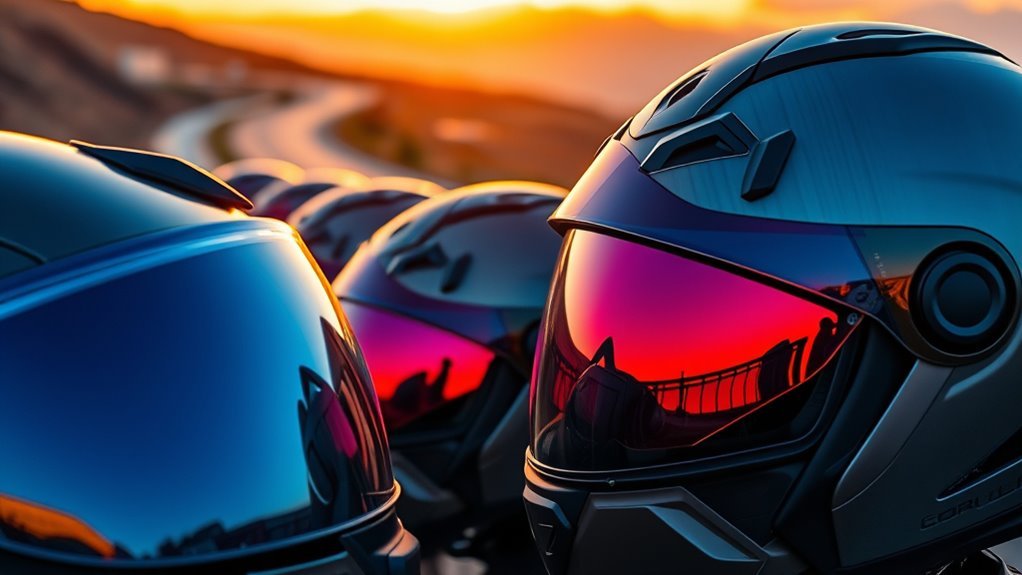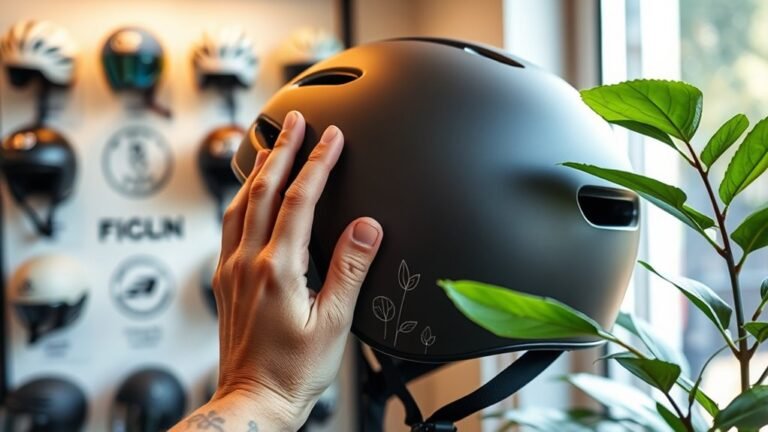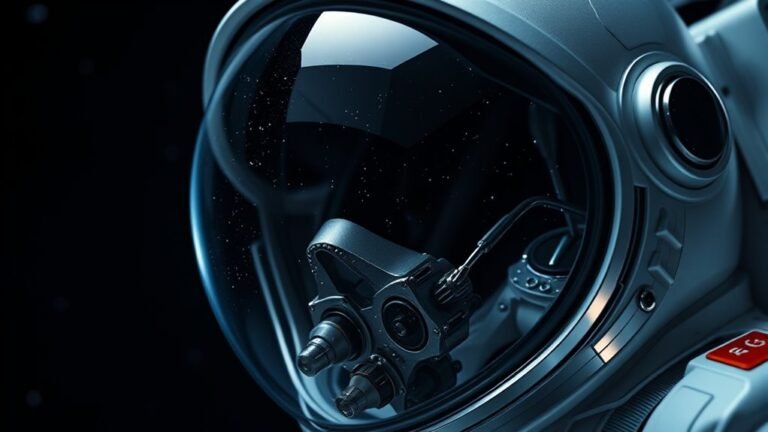Best Flip-Up Helmets for Touring Riders
When choosing the best flip-up helmets for touring riders, prioritize safety features like DOT and ECE certifications. Look for lightweight materials, comfortable padding, and adjustable ventilation to enhance your long rides. Helmets like the Schuberth C4 Pro and Nolan N100-5 offer excellent noise reduction and integrated communication. Guarantee a snug fit by measuring your head and evaluating adjustable options. To make sure you’re fully informed, you’ll find valuable insights on key aspects to examine next.
Features to Look for in Flip-Up Helmets
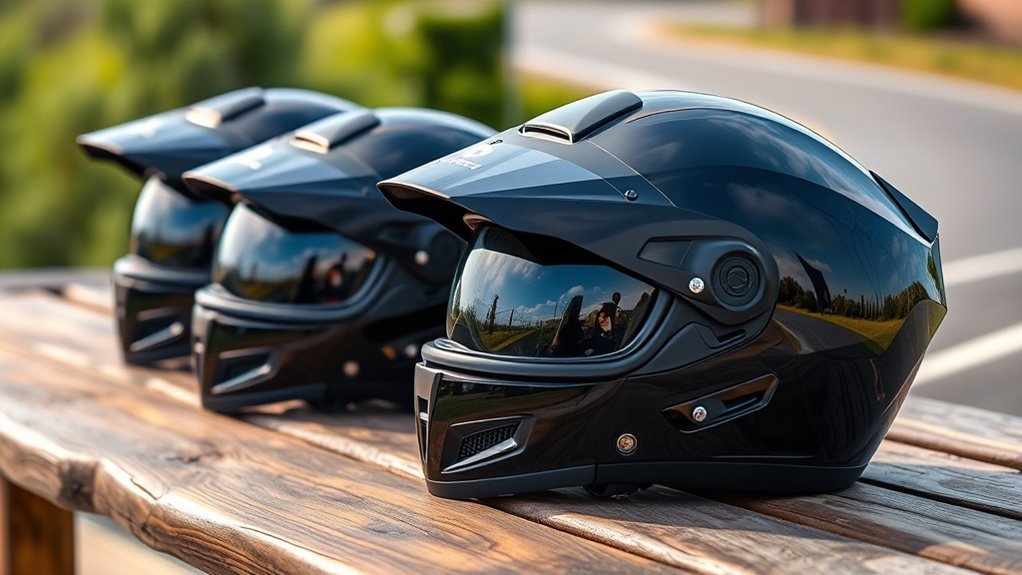
When considering a flip-up helmet for touring, it’s essential to focus on several key features that enhance both safety and comfort. Look for advanced materials like polycarbonate or fiberglass, which provide durability without adding unnecessary weight. A helmet with integrated technology, such as Bluetooth connectivity or noise-canceling features, can elevate your riding experience, allowing you to stay connected while on the road. Ventilation is also important; confirm the design promotes airflow to keep you cool during long rides. A comfortable interior lining, moisture-wicking properties, and removable padding can greatly enhance comfort. Finally, make sure the flip-up mechanism operates smoothly and securely, offering ease of use without compromising safety. Prioritize these features for an enjoyable and safe touring adventure.
Top Flip-Up Helmets for Long-Distance Touring
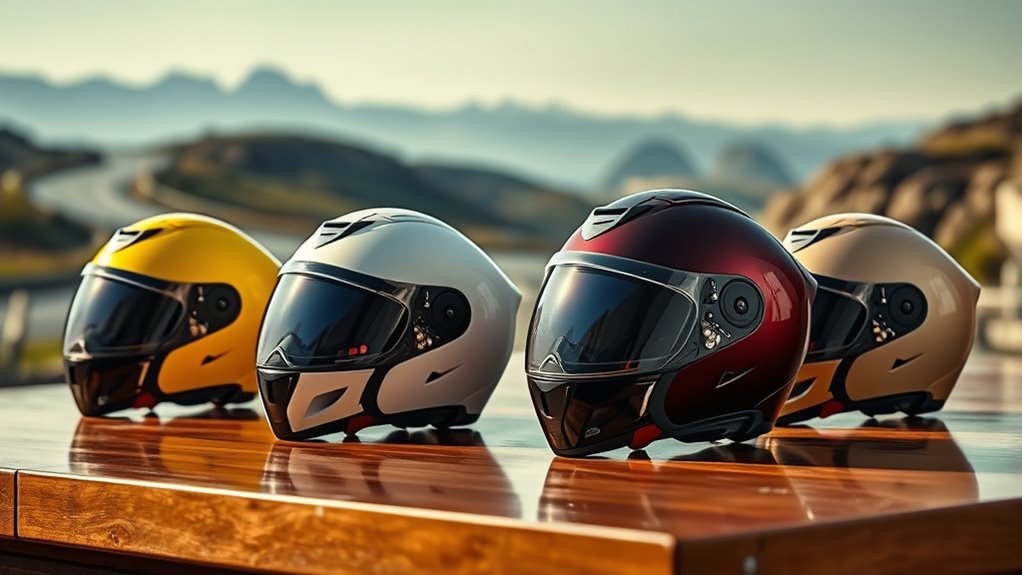
As you begin on long-distance touring, selecting the right flip-up helmet can greatly enhance your riding experience. Look for models that combine advanced helmet technology with essential touring features. The Schuberth C4 Pro offers excellent aerodynamic performance and exceptional noise reduction, ensuring a peaceful ride. The Nolan N100-5 is another top choice, featuring a spacious interior and integrated Bluetooth for seamless communication. For budget-conscious riders, the HJC IS-Max II provides solid protection with a lightweight design. Each of these helmets prioritizes safety while catering to your freedom on the road. When you choose wisely, you’re not just investing in gear; you’re enhancing your touring essentials and enjoying every mile with confidence and comfort.
Comfort and Fit: Finding the Right Size
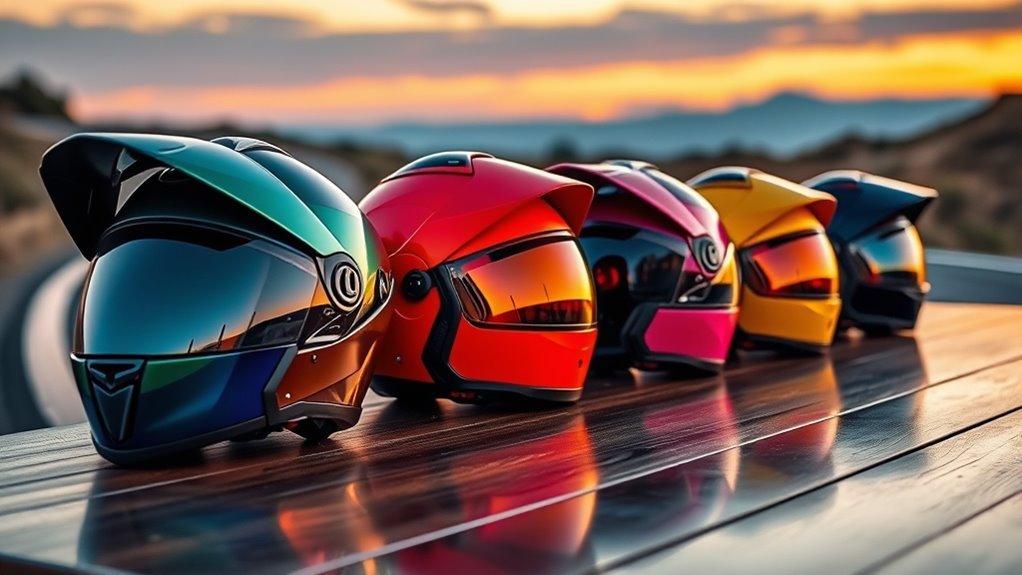
Finding the right size for your flip-up helmet is essential, since an improper fit can lead to discomfort and compromised safety on long rides. Start with accurate size measurement: use a soft tape to measure the circumference of your head, just above your eyebrows. This guarantees you get the right size according to the manufacturer’s chart. Remember, different brands might have slight variances, so always check their specific guidelines. Once you’ve got your helmet, make necessary helmet adjustments using the internal padding and straps for a snug fit. A properly fitted helmet should feel secure without causing pressure points. Achieving the right fit enhances comfort, allowing you to focus on the open road ahead, enjoying every mile of your journey.
Safety Ratings and Certifications
When choosing a flip-up helmet, understanding safety ratings and certifications is vital. The DOT certification guarantees compliance with minimum safety standards, while Snell standards offer a more rigorous testing process. Additionally, the ECE rating signifies that the helmet meets European safety requirements, providing you with important information to make an informed decision.
DOT Certification Importance
While you might be drawn to the sleek design and versatility of flip-up helmets, understanding the significance of DOT certification is essential for your safety on the road. DOT standards set rigorous benchmarks for helmet performance, ensuring they can withstand impacts and provide adequate protection. The certification process involves extensive testing, where helmets are subjected to various impact and penetration tests. Only those meeting or exceeding these standards receive the DOT label, which verifies their reliability. Choosing a DOT-certified helmet means you’re prioritizing your well-being and peace of mind while enjoying the freedom of the open road. Don’t compromise on safety; always check for that certification before hitting the highway with your flip-up helmet. Your adventure deserves the best protection.
Snell Standards Overview
Understanding the Snell standards is fundamental for anyone serious about helmet safety. The Snell Memorial Foundation sets rigorous helmet safety standards that go beyond basic requirements. This certification is essential because it guarantees that helmets provide superior impact protection, which is significant for touring riders who value freedom on the open road. Snell certification importance lies in its thorough testing, evaluating helmets under various conditions and impacts. A helmet that meets Snell standards has passed stringent tests for durability and performance, giving you confidence in its protective capabilities. When choosing a flip-up helmet, look for the Snell certification to guarantee you’re investing in a product that prioritizes your safety while you explore the world on your motorcycle.
ECE Rating Significance
Alongside Snell standards, the ECE (Economic Commission for Europe) rating plays a significant role in helmet safety assessments. This certification guarantees that helmets meet rigorous impact and penetration tests, critical for your protection as a touring rider. The ECE rating evaluates various factors, including energy absorption and retention system performance, making it a reliable indicator of helmet safety. When you’re out on the open road, knowing your helmet has passed these stringent tests gives you peace of mind. Additionally, ECE-rated helmets are often lighter and more comfortable, enhancing your riding experience. So, when choosing a flip-up helmet, prioritize those with an ECE rating to guarantee you’re not just riding free but also riding safely.
Ventilation and Noise Control
When you’re out on the open road, effective ventilation and noise control in a flip-up helmet can greatly enhance your riding experience. Look for helmets with multiple ventilation types, such as adjustable chin vents and top exhausts, to regulate airflow. These features help keep you cool during long rides, reducing fatigue. Additionally, helmets designed for ideal noise reduction can considerably decrease wind and road noise, allowing you to enjoy the freedom of the ride without distractions. Pay attention to the interior padding and seals, as they play a vital role in minimizing noise while maintaining comfort. A well-ventilated and quiet helmet not only elevates your ride but also guarantees you stay focused and refreshed for the journey ahead.
Visor Options and Visibility
While you’re maneuvering through diverse terrains, the visor options on your flip-up helmet greatly impact your visibility and safety. High-quality visors enhance visor clarity, allowing you to spot obstacles and enjoy the scenery without distortion. Look for helmets with integrated anti fog technology, which prevents moisture buildup, guaranteeing a clear view in varying weather conditions. Some models offer a tinted visor option for sunny days, reducing glare and enhancing comfort. Additionally, consider visors with UV protection to shield your eyes from harmful rays. When choosing a helmet, verify the visor is easy to operate with one hand, allowing you to adjust it while riding, contributing to your freedom on the open road. Visibility is essential to your adventure.
Maintenance and Care Tips
To keep your flip-up helmet in prime condition, regular cleaning is essential. Use a mild soap and water solution for the exterior, and verify the visor is free from scratches by using a soft microfiber cloth. When not in use, store your helmet in a cool, dry place to prevent damage from humidity and extreme temperatures.
Regular Cleaning Practices
Although you might enjoy the freedom of the open road, maintaining your flip-up helmet is essential for guaranteeing both safety and comfort during your tours. Regular cleaning practices can extend your helmet’s lifespan and guarantee its performance. Consider these maintenance tips based on helmet materials:
- Cleaning Frequency: Wipe the exterior weekly to remove dirt and debris, and deep clean every month.
- Material-Specific Care: Use a mild soap solution for polycarbonate or fiberglass shells; avoid harsh chemicals that can degrade the finish.
- Interior Maintenance: Remove and wash the liner regularly, guaranteeing it’s air-dried to prevent odors and bacteria buildup.
Storage Recommendations
Proper storage of your flip-up helmet is essential for maintaining its integrity and ensuring it serves you well on long tours. Here are some effective storage solutions and packing tips to keep your helmet in top shape:
| Storage Method | Description |
|---|---|
| Helmet Bag | Use a padded helmet bag to prevent scratches and impacts. |
| Dry Environment | Store in a cool, dry place away from direct sunlight. |
| Avoid Heavy Objects | Don’t place heavy items on top of your helmet to avoid deformation. |
| Regular Inspection | Check for damages regularly, especially after long rides. |
Following these recommendations will enhance your helmet’s longevity, allowing you to embrace the open road with confidence.
Budget Considerations for Touring Helmets
When reflecting on a flip-up helmet for touring, it’s essential to evaluate your budget alongside the features that matter most to you. You can find both affordable options and models with premium features, but understanding your priorities is key. Here are three factors to take into account:
- Safety Ratings: Verify the helmet meets safety standards, as this is non-negotiable for touring riders.
- Comfort & Fit: A well-fitted helmet enhances long rides; prioritize adjustable padding and ventilation.
- Weight: Lightweight options can reduce fatigue, especially on extended journeys.
Balancing these factors with your budget will help you make an informed decision, guaranteeing you enjoy the freedom of the open road without compromising safety or comfort.
Frequently Asked Questions
Can Flip-Up Helmets Accommodate Glasses or Sunglasses?
Yes, flip-up helmets can accommodate glasses or sunglasses, but fit and comfort vary by model. Look for helmets designed with lens compatibility features, like wider eye ports or adjustable padding, to guarantee your eyewear fits comfortably without pressure points. Additionally, consider the helmet’s interior shape; some designs provide extra room for glasses, enhancing overall comfort during long rides. Always try on the helmet with your eyewear to ascertain a secure and comfortable fit.
How Do I Clean the Interior Padding of a Flip-Up Helmet?
To clean the interior padding of your flip-up helmet, use gentle cleaning techniques suitable for the padding materials, like foam or fabric. Remove the padding if possible, and hand wash it in mild soapy water. Avoid harsh chemicals that could degrade the materials. Rinse thoroughly and let it air dry completely before reinserting. Regular cleaning not only maintains hygiene but also prolongs the helmet’s lifespan, giving you the freedom to ride confidently.
Are Flip-Up Helmets Suitable for Off-Road Riding?
Flip-up helmets aren’t typically ideal for off-road riding. While they offer convenience and versatility, their design can compromise off-road performance. The chin bar may not provide the same level of protection as traditional off-road helmets, which prioritize helmet safety in rugged conditions. If you’re seeking freedom on the trails, consider a dedicated off-road helmet that enhances visibility, ventilation, and protection, ensuring you ride confidently in challenging terrains without sacrificing safety.
What Is the Average Lifespan of a Flip-Up Helmet?
The average lifespan of a flip-up helmet is typically around three to five years, depending on usage and care. Helmet durability plays an essential role in this; exposure to sunlight, impacts, and regular wear can degrade materials over time. To guarantee your helmet remains safe, it’s wise to replace it after any significant impact or if you notice signs of wear. Remember, your safety on the open road is worth every penny!
Do Flip-Up Helmets Come With a Warranty?
Yes, flip-up helmets typically come with warranty coverage, which varies by manufacturer. It’s important to check the specifics since some brands offer limited warranties covering defects in materials and workmanship, while others may have more extensive policies. These warranties are essential for helmet safety; they guarantee that any potential issues are addressed, helping you maintain a reliable piece of gear. Always keep your receipt and register your helmet for full warranty benefits.
